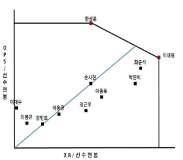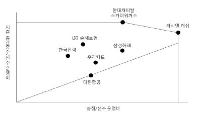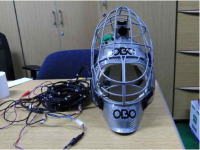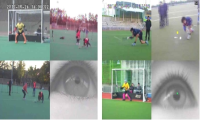PURPOSE This study theoretically explains the relationship between Keirin players’ core competencies and their performances. It also analyzes the impact of interaction between objectively identifiable core competencies and players’ efficiency toward their results, that is, the ability to convert their resources into performance. METHODS Using Python 3.11.1, 20,185 race records were collected of cyclists who competed at Gwangmyeong Velodrome in 2022 and 2023, and player efficiency was estimated using the R 4.3.1 package. Subsequently, the impact of players’ physical abilities (200 m records) on performance and player efficiency’s influence on the relationship between physical ability and performance were analyzed using Model 1 of PROCESS 4.1 Macro installed in SPSS 26.0. RESULTS First, players’ physical ability had a statistically significant impact on their performance. Specifically, the 200 m record significantly influenced the likelihood of finishing in the top 1 (coef = –.68 , p<.01 ), top 2 (coef = –.56, p<.01), and top 3 (coef = –.46, p<.01). Second, player efficiency moderated the relationship between players’ 200 m record and the likelihood of finishing within the top ranks. Specifically, the interaction term’s influence was empirically demonstrated between 200 m records and player efficiency on the likelihood of finishing within the top 1 (coef = –.47, p<.05), top 2 (coef = –.28, p<.05), and top 3 (coef = –.28, p<.05) for players with similar speeds, in that it significantly increased. CONCLUSIONS This study pioneers research that explains the relationship between players’ key competencies and performance based on resource-based theory, and it empirically demonstrates that player efficiency serves as a moderating variable in the relationship between key competencies and performance.

This paper analyze Korean baseball player's efficiency based on entire team and each team by using DEA (Data Envelopment Analysis) and use this efficiency to discuss effective way of recruiting players. Therefore, the purpose of this study was to evaluate each professional baseball team management efficiency through Data Envelopment Analysis. Player who were qualified free agent salary for the input variable and OPS and XR for output variable were used respectively then data were analyzed using Frontier Analyst 4.0. Also the recruiting factors of FA baseball player were confirmed by five baseball experts. we categorize the five factors of recruiting: age, durability, skill of improvement or decline, steady record, necessary position. The results were as follows. First, Han Sang-Hun and Lee Dae-Hyeong recorded the most efficient management among all professional baseball player. On the other hand, Choi showed inefficient management, followed by Park Han-Yi, Son Si-Heon, Lee Jong-wook, Jeong Keun-Woo, Lee Yong-Kyu, Lee Dae-Soo, Kang Min-Ho, Lee Byeong-Kyu.


Professional volleyball league, which was launched and its popularity was steadily increased since 2005, has suffered from difficulties in its operation due to deficits after 2013. In addition, each professional volleyball team has worked out for parent company so far as a means of advertisement but does not look like effective management. Therefore, the purpose of this study was to evaluate each professional female and male volleyball team management efficiency through Data Envelopment Analysis. Player salary for the input variable and points and the number of spectators for output variable were used respectively then data were analyzed using Frontier Analyst 4.0. The results were as follows. First, Hyndai capital and Rush & Cash recorded the most efficient management among all professional male volleyball team. On the other hand, Samsung showed inefficient management, followed by LIG, KEPCO, Woori Card, and Korean Air. Second, GS Caltex and IBK were discovered as the highest management efficiency among all professional female volleyball team. On the contrary, KGC recorded inefficient management, followed by Korea Expressway Corporation, Hyundai Construction and Heungkuk life.


The purpose of this study was to examine psychological capital acquisition through Asian Games Participation. 17 of national women football players were completed Psychological Capitals Questionnair. The psychological capital consists of optimism, psychological skills, self-management, collective efficacy, and performance perception was investigated after the team call-ups and before the team-release. The data was analyzed by paired t-test. As results, Korean women football players’ collective efficient and performance perception showed a statistical significance at the beginning of the team call-ups but optimism, psychological skills, and self-direction did not show statistic significances. The team-harmony, interpersonal-management, team-power, sufficient training, trust in coach, efficient communication, and psychological football factors, which were subfactor of football players’ psychological capital, showed statistical significances. However, confidence, concentration, goal-setting, imagery, willpower, anxiety-control, mental-management, life-management, training-management, innate-behavior management, physical-management, football skills, mediative skills, and football intelligence factors did not have statistic significances. These results demonstrate that effects of mega sporting events-like experiences and psychological factors’ variability and inflexibility according to weather changes should be considered when it comes to discussion of psychological factors regarding players’ performance. It is expected that this study would be a fundamental resource for understanding of psychological influences through participations in mega sporting events and discussions about further psychological interventions for teams with environmental consideration as well as methodological developments which could measure effects of the psychological interventions.
Purpose The purpose of this study was to analyze the relationship among emotional leadership, coach trust and athletic satisfaction of university. Methods 288 university soccer players were surveyed on the emotional leadership questionnaire, coach trust questionnaire and athletic satisfaction questionnaire through convenience sampling method. SPSS 23.0 and AMOS 23.0 were used to achieve the purpose of this study. Frequency analysis, confirmation factor analysis, reliability verification, correlation analysis and the structural equation model analysis were performed. Results First, emotional leadership had a positive effect on coach trust of university soccer players. Second, emotional leadership had a positive effect on athletic satisfaction of university soccer players. Third, coach trust had a positive effect on athletic satisfaction of university soccer players. Finally, coach trust mediated the relationship between emotional leadership and athletic satisfaction. Conclusions Emotional leadership was a leadership that can efficiently increase coach trust, and leaders must communicate with players through emotional effort and team operations with goals of athletic satisfaction and happiness rather than wins and losses were required.
Purpose The purpose of this study was to find out the physical characteristics of Wushu athletes by comparing the differences on the results of physical fitness between the male athletes of the Wushu national team Taolu and the Sanda group. Methods Measurement of basic and professional fitness based on muscle function, targeting 37 men Wushu national team players (24 taolu, 13 Sanda) in the selection and evaluation contests twice in 2018 and 2019. Body composition, isometric muscle strength, flexibility and equilibrium, anaerobic power, and isokinetic muscle strength. The fitness factors were divided into two groups, Taolu and Sanda. Results First, body fat rate of the Sanda athlete group was significantly lower than that of the taolu athlete group (p<.01). Second, in the isometric muscle strength category(back muscle strength, grip strength), the Sanda athlete group had higher muscle strength than Taolu athlete group, but there was a statistically significant difference only in the left grip strength (p<.01). Third, in terms of flexibility and equilibrium, the taolu players were significantly higher in all items(p<.001). Fourth, in the anaerobic power, the taolu athlete group had higher both the peak power and the mean power, and there were a significant differences(peak power: p<.01, mean power: p<.001). Fifth, isokinetic muscle strength was significantly higher in the right knee flexion of the taolu athlete group (p<.01), and lumbar extensor muscle was significantly higher in the Sanda athlete group (p<.05). Sixth, in the isokinetic strength ratio, the knee flexion ratio of the Sanda athlete group were significantly higher on the left and right knee flexion and extensor ratios (p<.05). In addition, in the lumbar flexor and extensor ratios, the group of Sanda athlete group were significantly higher on the lumbar extensor(p<.05). Seventh, there was no significant difference between two groups in isokinetic muscle power. Conclusions The results of this study can be used as basic data to improve the efficiency of technical and physical training through the analysis of the characteristics of Taolu and Sanda. The effectiveness of this training will help to improve the performance.

Purpose The purpose of this study was to compare the technique and power of the Korean national athletes and international athletes in the start phase of the 500 m speed skating to improve the performance and to understand the relationship between the biomechanical variables affecting the record. Method The subjects were 8 Korean national athletes (Korean athletes) and 6 international athletes (international athletes). For the three dimensional motion analysis, 5 high-speed cameras were used to capture the 40 m start phase of the athletes participating in the international competition. The variables selected for analysis were the kinematic chain, 100 m net time, time to 9 strokes, horizontal position of center of mass after 2.5 sec, range of motion of trunk, knee, push-off angle, net power output, total power loss. Results The correct kinematic chain ratio of Korean athletes was 61.2%, which was lower than 76.0% of international athletes. The time to 9 strokes was 2.82±0.25 sec for Korean athletes, which was significantly lower than 2.53±0.11 sec for international athletes (p=.001). The range of motion of the push-off angle was 60.15±2.75° for Korean athletes, which was significantly lower than 64.76±2.55° for international athletes (p=.001). The net power output was 887.2±269.9 W for Korean players and 1103±264.1 W for international players (p=.021). The variables related to the 100 m net time were the horizontal position of center of mass after 2.5 sec (r=-.956, p=.001), the net power output (r=-.931, p=.001), and the total power loss (r=-.904, p=.001). Conclusion In order to improve the start performance of Korean athletes, it is necessary to maximize the efficiency of skating through skill training to use the correct kinematic chain. Also power enhancement training is needed to improve leg power because the net power output related with 100 m net time.



The purpose of this study is to establish the efficient defensive strategy from analyzing the goalkeeper’s gaze behavior and defensive motion in both field hokey penalty corner and penalty stroke. To achieve this goal, 3 national team goalkeepers’ gaze behavior and defensive motions were analyzed, as well as the player’s visual strategies from their interview contents. For the apparatus, multi-channel integrational system were used for analyzing goalkeeper’s reaction movement and personal visual strategies. The result is as follow: First of all, In the penalty stroke, goalkeepers were tended to focus on the bottom of the shooter’s hokey stick. Second, national hokey players had quicker anticipating saccadic movement. For this reason, their visual fixation locations were arrived in targets earlier than the hockey ball. Lastly, in the interview contents, they were reported to focus just on the ball from not disturbed by other various objects(body, hockey stick). However, they actually observed various body parts of shooters. These results imply that we need to develop an effective perceptual skill training in order to anticipate the shooting performance more accurately and rapidly. These types of perceptual and cognitive skill training should be conducted with information on knowing their specific visual cues in anticipating shooting direction.

